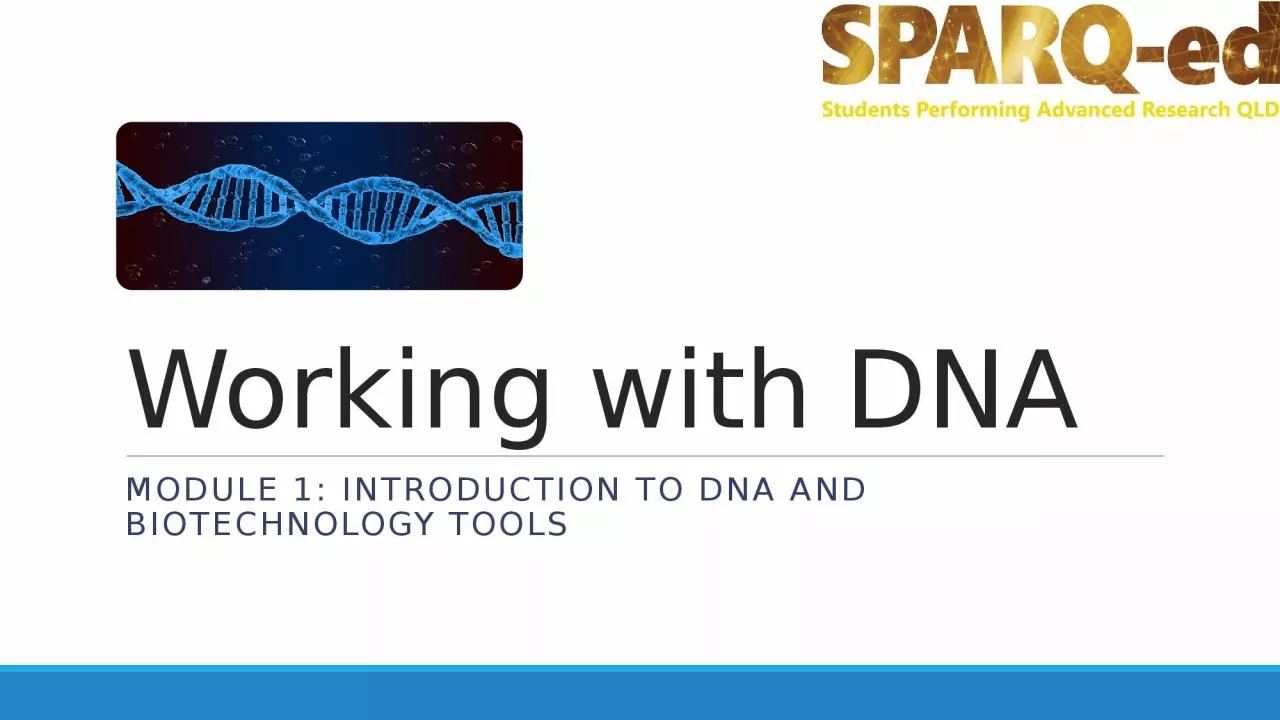

Biotechnology Recombinant DNA and Cloning Module 1 presentation B Biotechnology Recombinant DNA and Cloning Learning intention Describe the process of making recombinant DNA Success criteria ID: 1043904
Download Presentation The PPT/PDF document "Working with DNA Module 1: Introduction..." is the property of its rightful owner. Permission is granted to download and print the materials on this web site for personal, non-commercial use only, and to display it on your personal computer provided you do not modify the materials and that you retain all copyright notices contained in the materials. By downloading content from our website, you accept the terms of this agreement.
1. Working with DNA Module 1: Introduction to DNA and Biotechnology Tools
2. Biotechnology: Recombinant DNA and CloningModule 1 presentation B
3. Biotechnology: Recombinant DNA and CloningLearning intention Describe the process of making recombinant DNASuccess criteria Define the term “cloning” Describe the process of cloning a gene Identify tools in making recombinant DNAwww.addgene.org
4. This is because…DNA technologies are used in a range of industries; your body and your food are made of cells with DNA and protein.
5. Recombinant DNA and Cloning – PurposesTo express (produce) a protein for use in medicine or research (E.g. production of insulin)To study a gene in a lab To change the phenotype of a faulty gene that is causing disease in a patient (gene therapy) Change or introduce a new phenotype into a food organismRecombinant DNA/ biotechnology involves genetic engineering, which relates to the cutting and pasting of DNA and introducing genes into different organisms.
6. Recombinant DNASome tools and techniquesPCR (polymerase chain reaction)Restriction enzymesDNA ligasePlasmid vectors
7. CloningClone (verb) definition:1. to bring about the asexual reproduction of (an individual)………..2. to replicate exactly.(Source Macquarie Dictionary online)Fill in the blanks on p 3 of resource B
8. Gene Cloning ProcessRecombinant DNA technologyClone: to bring about asexual reproduction… the resulting individual being identical; to replicate exactly
9. Gene Cloning ProcessSPARQ-ed workshop starts hereComplete p 3 of resource B
10. Recombinant DNA Tools & TechniquesEnzymes Restriction enzymesDNA ligaseOther PlasmidsGel electrophoresis Chromatography columnswww.genomecompiler.com…and many more!While you go through the next 5 slides, complete table 1 on page 4.
11. Restriction EndonucleasesAlso known as “restriction enzymes,” these are enzymes that catalyse the chemical break down of DNA at very specific places, therefore cutting it into particular sized fragments. Image from Nature of Biology 2 (Jacaranda) (2013)
12. DNA LigaseThis is an enzyme that sticks pieces of DNA together.Image from Nature of Biology 2 (Jacaranda) (2013)
13. PlasmidVector = something that carries/transports a gene or microbe from one organism to another.Diagram of bacterial transformation by Thermo Fisher Scientific.Conjugation of a plasmid from one bacterial cell to another (Commons Wikimedia).A small circular piece of DNA from bacteria. Can be used as gene vectors.
14. Chromatography Columnhttps://www.researchgate.net/figure/Working-steps-of-affinity-chromatography_fig21_2348413021.Add lysed (broken open) cells to column2. Molecule (e.g. DNA) binds to beads. Other molecules flow through.3. Change the pH and elute the molecule of interest (e.g. DNA)
15. Gel Electrophoresishttps://learn.genetics.utah.edu/content/labs/gel/https://socratic.org/questions/why-is-gel-electrophoresis-important
16. https://di.uq.edu.au/sparq-edsparqed@uq.edu.au